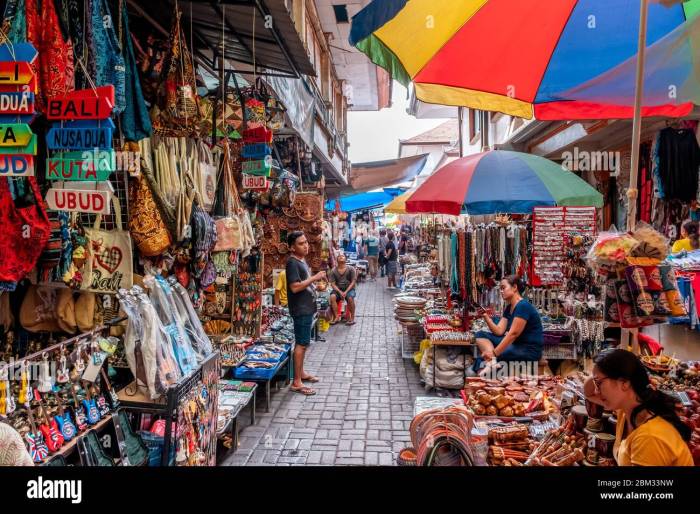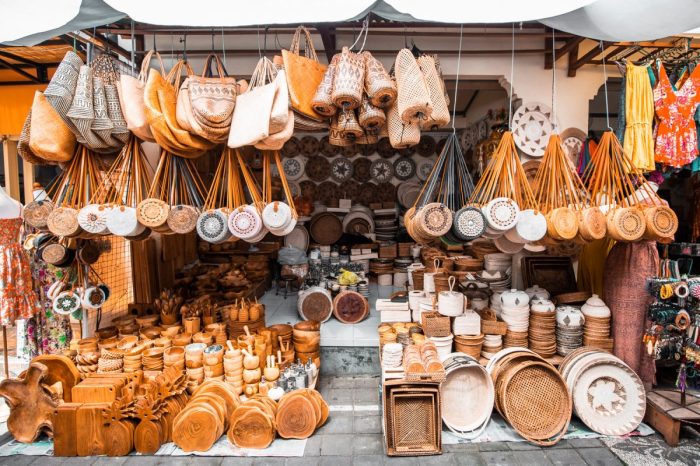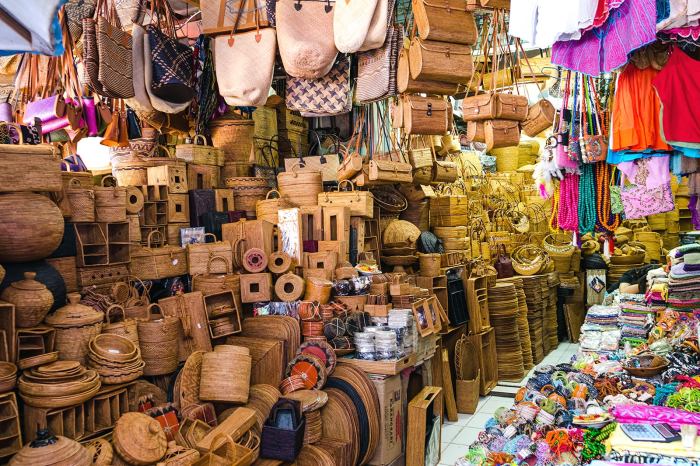Step into the enchanting Ubud Art Market, where art enthusiasts and culture seekers converge. Nestled amidst the lush greenery of Ubud, this vibrant marketplace showcases the extraordinary talents of local artists and artisans, offering a glimpse into the rich artistic traditions of Bali.
From intricate paintings that capture the essence of Balinese life to captivating sculptures that embody ancient myths and legends, the Ubud Art Market is a treasure trove of artistic wonders.
Market Overview
The Ubud Art Market is a bustling hub of creativity and commerce in the heart of Ubud, Bali. With a history dating back to the 1950s, the market has grown into one of the most renowned art markets in Southeast Asia, attracting visitors from around the world.
The market is spread across several blocks, with hundreds of stalls showcasing a diverse range of artwork from local and international artists. Visitors can find everything from traditional Balinese paintings and sculptures to contemporary abstract pieces, handmade textiles, and intricate crafts.
Types of Art Available
The Ubud Art Market is renowned for its wide selection of art forms, catering to various tastes and preferences. Here are some of the most popular types of art available in the market:
- Paintings:From traditional Balinese paintings depicting scenes from Hindu mythology to modern abstract masterpieces, the market offers a vast collection of paintings in various styles and mediums.
- Sculptures:Intricate wood carvings, stone sculptures, and metalwork pieces are a common sight in the market. Artists showcase their skills in creating both traditional and contemporary sculptures.
- Textiles:Ubud is known for its vibrant textiles, and the market is a great place to find handmade batik fabrics, ikat weavings, and traditional Balinese clothing.
- Crafts:From handmade jewelry and ceramics to woven baskets and bamboo crafts, the market offers a wide range of unique and intricate crafts.
Key Artists and Styles

The Ubud art market is a vibrant hub for artists and art enthusiasts, showcasing a diverse range of styles and artistic expressions. Over the years, several key artists have emerged, each contributing to the unique character of the market.
These artists draw inspiration from traditional Balinese motifs, contemporary themes, and the natural beauty of the surrounding landscape. Their works reflect a blend of traditional techniques and modern influences, creating a captivating fusion of art forms.
Wayan Gde Sudarta
- Known for his intricate woodcarvings and sculptures, Wayan Gde Sudarta is a renowned master of traditional Balinese art.
- His works depict mythological scenes, deities, and everyday life, capturing the essence of Balinese culture.
- Sudarta’s sculptures are characterized by their fine details, expressive figures, and intricate patterns.
I Nyoman Masriadi
- A contemporary artist, I Nyoman Masriadi is known for his abstract paintings and installations.
- His works explore themes of identity, spirituality, and the human condition.
- Masriadi’s paintings often feature vibrant colors, gestural brushstrokes, and layered textures, creating a dynamic and evocative visual experience.
Ni Nyoman Sani
- Ni Nyoman Sani is a renowned batik artist known for her intricate and colorful designs.
- Her batiks depict scenes from Balinese mythology, traditional ceremonies, and everyday life.
- Sani’s batiks are characterized by their vibrant colors, flowing lines, and intricate patterns, reflecting the beauty and diversity of Balinese culture.
Cultural Significance

The Ubud Art Market is a hub of artistic expression that embodies the rich cultural heritage of Ubud and Bali. It showcases the vibrant artistry of local craftsmen, fostering a sense of community and cultural preservation.
The market serves as a platform for Balinese artists to display their traditional skills and contemporary interpretations of ancient techniques. Through its intricate carvings, vibrant paintings, and delicate textiles, the market reflects the island’s artistic traditions, preserving and promoting Balinese culture.
After immersing yourself in the vibrant Ubud Art Market, take a short drive to the Tegalalang Rice Terrace , a breathtaking natural wonder. Witness the lush greenery and intricate patterns of the terraced paddies, capturing the essence of Bali’s agricultural heritage.
As you return to the bustling market, you’ll appreciate the contrast between the tranquility of nature and the vibrant energy of Ubud’s artistic hub.
Role in Preserving and Promoting Balinese Art
- Provides a venue for local artisans to showcase their creations, ensuring the continuity of traditional art forms.
- Fosters cultural exchange and appreciation, exposing visitors to the unique artistic expressions of Bali.
- Supports the livelihood of local artists, contributing to the economic and cultural well-being of the community.
- Promotes Balinese art on a global scale, attracting collectors and enthusiasts from around the world.
Economic Impact
The Ubud Art Market is a significant economic driver for the local community and the wider Ubud region. It provides a platform for local artists and artisans to showcase and sell their work, contributing to the preservation and promotion of traditional Balinese arts and crafts.
The market generates substantial revenue through the sale of artwork, souvenirs, and other items. This revenue directly benefits local artists and their families, supporting their livelihoods and enabling them to continue practicing their craft.
The Ubud Art Market is a must-visit for art enthusiasts, offering a wide variety of traditional and contemporary pieces. After exploring the market, take a refreshing break at one of the many waterfalls in Ubud. Cool off in the pristine waters, surrounded by lush greenery.
Afterwards, return to the market to continue your shopping experience, where you’ll find unique souvenirs and gifts to cherish your time in Ubud.
Contribution to Local Economy
- Employment: The market provides employment opportunities for numerous individuals, including artists, artisans, vendors, and support staff.
- Tourism: The market attracts a large number of tourists, contributing to the local tourism industry and generating revenue for businesses such as hotels, restaurants, and tour operators.
- Cultural Preservation: The market plays a crucial role in preserving and promoting traditional Balinese arts and crafts, ensuring their continued existence and cultural significance.
Market Trends and Future Prospects

The Ubud art market is constantly evolving, with new trends and developments emerging all the time. One of the most notable trends in recent years has been the growing popularity of contemporary Indonesian art. This is due in part to the increasing number of Indonesian artists gaining international recognition, as well as the growing demand for contemporary art from collectors around the world.Another trend in the Ubud art market is the increasing use of social media to promote and sell art.
This has made it easier for artists to reach a wider audience and for collectors to find and purchase art from all over the world.
Challenges and Opportunities, Ubud art market
The Ubud art market is not without its challenges. One of the biggest challenges is the lack of regulation. This can make it difficult for artists to protect their intellectual property and for collectors to ensure that they are purchasing authentic works of art.Another challenge is the competition from other art markets in Southeast Asia, such as Singapore and Hong Kong.
These markets have more developed infrastructure and a larger pool of collectors, which can make it difficult for Ubud to compete.However, the Ubud art market also has a number of opportunities. One of the biggest opportunities is the growing number of tourists visiting Ubud.
This provides artists with a large pool of potential customers.Another opportunity is the increasing demand for Indonesian art from collectors around the world. This demand is being driven by the growing popularity of contemporary Indonesian art, as well as the increasing awareness of Indonesian culture and heritage.
Future Prospects
The future prospects for the Ubud art market are bright. The market is expected to continue to grow in the coming years, as more and more people discover the beauty and diversity of Indonesian art.One of the key factors that will drive the growth of the market is the increasing number of Indonesian artists gaining international recognition.
If you’re seeking unique artistic treasures, Ubud Art Market is a must-visit. Explore its vibrant stalls showcasing traditional paintings, intricate carvings, and handmade textiles. While in Southeast Asia, consider venturing to Phuket , renowned for its stunning beaches and vibrant nightlife.
Upon returning to Ubud Art Market, continue your art exploration, immersing yourself in the captivating creations of local artisans.
This will help to raise the profile of Indonesian art and make it more attractive to collectors around the world.Another factor that will drive the growth of the market is the increasing demand for Indonesian art from collectors in Southeast Asia.
This demand is being driven by the growing affluence of the region and the increasing awareness of Indonesian culture and heritage.Overall, the future prospects for the Ubud art market are very positive. The market is expected to continue to grow in the coming years, as more and more people discover the beauty and diversity of Indonesian art.
Visitor Experience
The Ubud art market is a vibrant and bustling hub, offering visitors an immersive cultural experience. As you step into the market, you’ll be greeted by a kaleidoscope of colors, intricate carvings, and the sound of traditional music.
The atmosphere is friendly and welcoming, with vendors eager to share their knowledge and passion for their crafts. You can wander through the narrow aisles, admiring the diverse range of artwork and chatting with the artists.
Amenities and Activities
The market provides a range of amenities to enhance the visitor experience, including:
- Food and drink stalls offering local delicacies and refreshments
- Rest areas where you can take a break and soak up the atmosphere
- Free Wi-Fi to stay connected and share your discoveries
In addition to browsing the artwork, visitors can participate in workshops and demonstrations, where they can learn traditional painting techniques, woodcarving, or batik making.
Tips for Visitors
- Plan to spend several hours at the market to fully appreciate its offerings.
- Bring cash as most vendors do not accept credit cards.
- Be prepared to bargain, but always do so respectfully.
- Don’t be afraid to ask questions and learn about the stories behind the artwork.
- Take your time and enjoy the experience of immersing yourself in Balinese culture.
Art Galleries and Workshops

Ubud is home to a thriving art scene, with numerous galleries and workshops showcasing the works of local and international artists. These establishments play a crucial role in fostering the artistic community and promoting Ubud’s reputation as a cultural hub.
The galleries in Ubud offer a diverse range of artistic styles, from traditional Balinese paintings to contemporary sculptures and mixed media installations. Many galleries also host exhibitions, workshops, and artist talks, providing opportunities for visitors to engage with the artists and learn about their creative processes.
Notable Art Galleries and Workshops
- ARMA Museum:This museum showcases a comprehensive collection of traditional and contemporary Balinese art, including paintings, sculptures, and textiles. It also offers guided tours and workshops on Balinese art techniques.
- Neka Art Museum:This museum houses a large collection of Balinese paintings, including works by renowned artists such as I Gusti Nyoman Lempad and Ida Bagus Made Togog. It also has a library and research center specializing in Balinese art.
- Ubud Art Market:This market is a hub for local artists and artisans, offering a wide variety of paintings, sculptures, crafts, and souvenirs. Visitors can find everything from traditional Balinese masks to modern abstract art.
- Komaneka Fine Art Gallery:This gallery showcases contemporary Indonesian and international art, with a focus on paintings and sculptures. It represents a diverse group of artists and hosts regular exhibitions.
- Threads of Life:This non-profit organization supports traditional textile arts in Indonesia. It offers workshops, exhibitions, and a retail store where visitors can purchase handwoven textiles and other crafts.
These galleries and workshops contribute to the Ubud art scene by providing a platform for artists to showcase their work, fostering creative exchange, and educating visitors about Balinese art and culture.
Art Education and Outreach

Art education and outreach programs play a vital role in fostering the growth and appreciation of art in Ubud. These initiatives aim to cultivate artistic skills, nurture creativity, and promote cultural understanding within the local community and beyond.
Various organizations and institutions are actively involved in art education and outreach in Ubud. These include:
Programs and Initiatives
- Ubud Art Market Education Program:This program provides art classes, workshops, and mentorship opportunities for local artists and aspiring creatives.
- Yayasan Gaya:A non-profit organization that offers art education programs, exhibitions, and artist residencies, supporting emerging artists and preserving traditional art forms.
- Seniman Coffee Studio:A community-based initiative that hosts art exhibitions, workshops, and discussions, fostering dialogue and collaboration among artists.
These programs and initiatives create a vibrant and supportive environment for art education and appreciation. They empower local artists, provide opportunities for artistic expression, and cultivate a deep understanding of the cultural significance of art in Ubud.
Summary
As you delve deeper into the market’s labyrinthine paths, you’ll discover a vibrant community of artists, each with their unique style and story to share. The Ubud Art Market is not just a place to purchase exquisite artwork; it’s a cultural tapestry that weaves together the past, present, and future of Balinese art.
FAQ Resource: Ubud Art Market
What are the opening hours of the Ubud Art Market?
The market is open daily from 8 am to 6 pm.
Is it possible to bargain with vendors at the market?
Yes, bargaining is common in the Ubud Art Market. Be respectful and polite when negotiating prices.
Can I find original artwork at the market?
Yes, the market features a wide range of original artwork created by local artists.